Electric light
Most of the industrialized world is lit by electric lights, which are used both at night and to provide additional light during the daytime. These lights are normally powered by the electric grid, but some run on local generators, and emergency generators serve as backups in hospitals and other locations where a loss of power could be catastrophic. Battery-powered lights, usually called “flashlights” or “torches”, are used for portability and as backups when the main lights fail.
Types
Types of electric lighting include:
- incandescent light bulbs
- arc lamps
- gas discharge lamps, e.g., fluorescent lights and Compact fluorescent lamps, neon lamps, flood lamps, modern photographic flashes
- lasers
- light-emitting diodes, including OLEDs
- sulfur lamps
Different types of lights have vastly differing efficiencies and color of light.
| Name | optical spectrum | nominal efficiency (lm/W) |
Lifetime (MTBF) (hours) |
Colour temperature (kelvins) |
Colour | Color rendering index |
|---|---|---|---|---|---|---|
| Incandescent light bulb | Continuous | 12-17 | 1000-2500 | 2700 | Warm white (yellowish) | 100 |
| Halogen lamp | Continuous | 16-23 | 3000-6000 | 3200 | Warm white (yellowish) | 100 |
| Fluorescent lamp | Mercury line + Phosphor | 52-100 | 8000-20000 | 2700-5000* | White (with a tinge of green) | 15-85 |
| Metal halide lamp | quasi-Continuous | 50-115 | 6000-20000 | 3000-4500 | Cold White | 65-93 |
| Sulfur lamp | Continuous | 80-110 | 15000-20000 | 6000 | Pale green | 79 |
| High pressure sodium | broadband | 55-140 | 10000-40000 | 1800-2200* | Pinkish orange | 0-70 |
| Low pressure sodium | narrow line | 100-200 | 18000-20000 | 1800* | Yellow, virtually no color rendering | 0 |
*Color temperature is defined as the temperature of a black body emitting a similar spectrum; these spectra are quite different from those of black bodies.
The most efficient source of electric light is the low-pressure sodium lamp. It produces an almost monochromatic orange light, which severely distorts color perception. For this reason, it is generally reserved for outdoor public lighting usages. Low-pressure sodium lights are favoured for public lighting by astronomers, since the light pollution that they generate can be easily filtered, contrary to broadband or continuous spectra.
Incandescent light bulb
Incandescent light bulb as we know it today, with a coiled filament of tungsten, was commercialised in the 1920s developed from the carbon filament lamp introduced in about 1880. As well as bulbs for normal illumination, there is a very wide range, including low voltage, low-power types often used as components in equipment, but now largely displaced by LEDs
There is currently interest in banning some types of filament lamp in some countries, such as Australia planning to ban standard incandescent light bulbs by 2010, because they are inefficient at converting electricity to light.Sri Lanka has already banned importing filament bulbs because of high use of electricity and less light. Less than 3% of the input energy is converted into usable light. Nearly all of the input energy ends up as heat that, in warm climates, must then be removed from the building by ventilation or air conditioning, often resulting in more energy consumption. In colder climates where heating and lighting is required during the cold and dark winter months, the heat byproduct has at least some value.
Halogen lamp
Halogen lamps are usually much smaller than standard incandescents, because for successful operation a bulb temperature over 200°C is generally necessary. For this reason, most have a bulb of fused silica (quartz), but sometimes aluminosilicate glass. This is often sealed inside an additional layer of glass. The outer glass is a safety precaution, reducing UV emission and because halogen bulbs can occasionally explode during operation. One reason is if the quartz bulb has oily residue from fingerprints. The risk of burns or fire is also greater with bare bulbs, leading to their prohibition in some places unless enclosed by the luminaire. Those designed for 12V or 24V operation have compact filaments, useful for good optical control, also they have higher efficacies (lumens per watt) and better lives than non halogen types. The light output remains almost constant throughout life.
Fluorescent lamp
Fluorescent lamps have much higher efficacy than filament lamps. For the same amount of light generated, they typically use around ¼ to ⅓ the power of an incandescent.
Fluorescents were mostly limited to linear and a round ‘Circline’ lamp until the 1980s, with other shapes never gaining much popularity. The compact fluorescent lamp (CFL) was commercialised in the early 1980s.
Most CFLs have a built-in electrical ballast and fit into a standard screw or bayonet base. Some make use of a separate ballast so that the ballast and tube can be replaced separately.
Typical average lifetime ratings for linear fluorescent tubes are 10,000 and 20,000 hours, compared to 750 hours (110 V) and 1000 hours (240 V) for filament lamps.
Some types of fluorescent lamp ballast have difficulty starting lamps in very cold conditions, so lights used outdoors in cold climates need to be designed for outdoor use to work reliably.
Fluorescents come in a range of different colour temperatures. In some countries cool white (CW) is most popular, while in some, warmer whites predominate.
In America, fluorescents most often come in cool white (CW), with some home bulbs being a warm white (WW), which has a pinkish color. In between there is an “enhanced white” (EW), which is more neutral. There is also a very cold daylight white (DW). Compact fluorescent lamps are usually considered warm white, though many have a yellowish cast like an incandescent. “Warm” and “cool” are entirely relative terms and almost arbitrary so color temperature and the color rendering index (CRI) are used as absolute scales of color for fluorescents, and sometimes for other types of lighting.
LED lamp
Solid state LEDs have been popular as indicator lights since the 1970s. In recent years, efficacy and output have risen to the point where LEDs are now being used in niche lighting applications.
Indicator LEDs are known for their extremely long life, up to 100,000 hours, but lighting LEDs are operated much less conservatively (due to high LED cost per watt), and consequently have much shorter lives.
Due to the relatively high cost per watt, LED lighting is most useful at very low powers, typically for lamp assemblies of under 10w. LEDs are currently most useful and cost-effective in low power applications, such as nightlights and flashlights. Colored LEDs can also be used for accent lighting, such as for glass objects, and even in fake ice cubes for drinks at parties. They are also being increasingly used as holiday lighting.
LED efficacies vary over a very wide range. Some have lower efficacy than filament lamps, and some significantly higher. LED performance in this respect is prone to being misinterpreted, as the inherent directionality of LEDs gives them a much higher light intensity in one direction per given total light output.
Single colour LEDs are well developed technology, but white LEDs at time of writing still have some unresolved issues.
- CRI is not particularly good, resulting in less than accurate colour rendition.
- The light distribution from the phosphor does not fully match the distribution of light from the LED die, so colour temperature varies at differing angles.
- Phosphor performance degrades over time, resulting in change of colour temperature and falling output. With some LEDs degradation can be quite fast.
- Limited heat tolerance means that the amount of power packable into a lamp assembly is a fraction of the power usable in a similarly sized incandescent lamp.
LED technology is useful for lighting designers because of its low power consumption, low heat generation, instantaneous on/off control, and in the case of single colour LEDs, continuity of color throughout the life of the diode and relatively low cost of manufacture.
In the last few years, software has been developed to merge lighting and video by enabling lighting designers to stream video content to their LED fixtures, creating low resolution video walls.
For general domestic lighting, total cost of ownership of LED lighting is still much higher than for other well established lighting types.
Carbon arc lamp
Carbon arc lamps consist of 2 carbon rod electrodes in open air, supplied by a current-limiting ballast. The electric arc is struck by touching the rods then separating them. The ensuing arc heats the carbon tips to white heat. These lamps have higher efficacy than filament lamps, but the carbon rods are short lived and require constant adjustment in use. The lamps produce significant ultra-violet output, they require ventilation when used indoors, and due to their intensity they need protecting from direct sight.
Carbon arc lamps operate at high powers, and had high efficacy compared to other pre-1920s light sources. They also are a point source of light. These properties made them ideally suited to search lights, follow spots and film projector lights.
Their need for ongoing attendance and adjustment, and frequent rod replacement made them ill suited to general lighting, though they were used for high power lighting in the years when nothing else with comparable output power existed. Carbon arcs fell out of use even for niche applications during and after World War 2.
Discharge lamp
A discharge lamp has a glass or silica envelope containing 2 metal electrodes separated by a gas. Gases used include, neon, argon, xenon, sodium, metal halide, and mercury.
The core operating principle is much the same as the carbon arc lamp, but the term ‘arc lamp’ is normally used to refer to carbon arc lamps, with more modern types of gas discharge lamp normally called ‘discharge lamps’.
With some discharge lamps, very high voltage is used to strike the arc. This requires an electrical circuit called an igniter, which is part of the ballast circuitry. After the arc is struck, the internal resistance of the lamp drops to a low level, and the ballast limits the current to the operating current. Without a ballast, excess current would flow, causing rapid destruction of the lamp.
Some lamp types contain a little neon, which permits striking at normal running voltage, with no external ignitor circuitry. Low pressure sodium lamps operate this way.
The simplest ballasts are just an inductor, and are chosen where cost is the deciding factor, such as street lighting. More advanced electronic ballasts may be designed to maintain constant light output over the life of the lamp, may drive the lamp with a square wave to maintain completely flicker-free output, and shut down in the event of certain faults. These more complex ballasts are chosen in the film industry for example.
Lamp Life Expectancy
Life expectancy is defined as the number of hours of operation for a lamp until 50% of them fail. This means that it is possible for some lamps to fail after a short amount of time and for some to last significantly longer than the rated lamp life. This is an average (median) life expectancy. Production tolerances as low as 1% can create a variance of 25% in lamp life. For LEDs, lamp life is when 50% of lamps have lumen output drop to 70% or less.
Lamps are also sensitive to switching cycles. The rapid heating of a lamp filament or electrodes when a lamp is turned on is the most stressful event on the lamp. Most test cycles have the lamps on for 3 hours and then off for 20 minutes. (Some standard had to be used since it’s unknown how the lamp will be used by consumers.) This switching cycle repeats until the lamps fail and the data is recorded. If switching is increased to only 1 hour on, the lamp life is usually reduced because the number of times the lamp has been turned on has increased. Rooms with frequent switching (bathroom, bedrooms, etc.) can expect much shorter lamp life than what is printed on the box.
Public lighting
The total amount of artificial light (especially from street light) is sufficient for cities to be easily visible at night from the air, and from space. This wasted light is the source of light pollutionthat burdens astronomers and others.

Human-made lights highlight particularly developed or populated areas of the Earth’s surface, including the seaboards of Europe, the eastern United States, and Japan.
Lamp (electrical component)
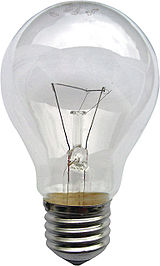
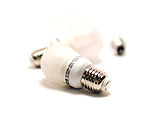 A lamp is a replaceable component such as an incandescent light bulb, which is designed to produce light from electricity. These components usually have a base of ceramic, metal, glass or plastic, which makes an electrical connection in the socket of a light fixture. This connection may be made with a screw-thread base, two metal pins, 2 metal caps or a bayonet cap. Re-lamping is the replacement of only the removable lamp in a light fixture.
A lamp is a replaceable component such as an incandescent light bulb, which is designed to produce light from electricity. These components usually have a base of ceramic, metal, glass or plastic, which makes an electrical connection in the socket of a light fixture. This connection may be made with a screw-thread base, two metal pins, 2 metal caps or a bayonet cap. Re-lamping is the replacement of only the removable lamp in a light fixture.
Lamps in electronics
Filament lamps have long been used as fast acting thermistors in electronic circuits. Popular uses have included:
- Stabilisation of sine wave oscillators
- Protection of tweeters
- Automatic volume control in telephones
Lamp circuit symbols
In circuit diagrams lamps usually are shown as symbols. There are two main types of symbols, these are:


a lamp as an indicator (left), a lamp as a source of light or illumination (right)
Fluorescent ->
High-intensity discharge (HID) ->
Gas discharge ->
- Neon · Xenon arc / Xenon flash ·
- Cold cathode · Black light · Tanning lamp ·
- Germicidal · Growth light
Electric arc ->
Combustion ->
Other ->
Emergency light
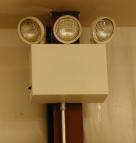 An emergency light is a battery-backed lighting device that comes on automatically when a building experiences a power outage. Emergency lights are standard in new commercial and high occupancy residential buildings, such as college dormitories. Most building codes require that they be installed in older buildings as well.
An emergency light is a battery-backed lighting device that comes on automatically when a building experiences a power outage. Emergency lights are standard in new commercial and high occupancy residential buildings, such as college dormitories. Most building codes require that they be installed in older buildings as well.
History
By the nature of the device, an emergency light is designed to come on when the power goes out. Every model, therefore, requires some sort of a battery or generator system that could provide electricity to the lights during a blackout. The earliest models were incandescent light bulbs which could dimly light an area during a blackout and perhaps provide enough light to solve the power problem or evacuate the building. It was quickly realized, however, that a more focused, brighter, and longer-lasting light was needed. The modern emergency floodlightprovides a high-lumen, wide-coverage light that can illuminate an area quite well. Some lights are halogen, and provide a light source and intensity similar to that of an automobile headlight.
Early battery backup systems were huge, dwarfing the size of the lights for which they provided power. The systems normally used lead acid batteries to store a full 120-volt charge. For comparison, an automobile uses a single lead acid battery as part of the ignition system. Simple transistor or relay technology was used to switch on the lights and battery supply in the event of a power failure. The size of these units, as well as the weight and cost, made them relatively rare installations. As technology developed further, the voltage requirements for lights dropped, and subsequently the size of the batteries was reduced as well. Modern lights are only as large as the bulbs themselves – the battery fits quite well in the base of the fixture.
Modern installations
Modern emergency lighting is installed in virtually every commercial and high occupancy residential building. The lights consist of one or more incandescent bulbs or one or more clusters of high-intensity light-emitting diodes (LED). The emergency lighting heads are usually either PAR 36 sealed beams or wedge base lamps. All units have some sort of a reflector to focus and intensify the light they produce. This can either be in the form of a plastic cover over the fixture, or a reflector placed behind the light source. Most individual light sources can be rotated and aimed for where light is needed most in an emergency, such as toward fire exits. Modern fixtures usually have a test button of some sort which temporarily overrides the unit and causes it to switch on the lights and operate from battery power even if the main power is still on. Modern systems are operated with relatively low voltage, usually from 6-12 volts. This both reduces the size of the batteries required and reduces the load on the circuit to which the emergency light is wired. Modern fixtures include a small transformer in the base of the fixture which steps-down the voltage from main current to the low power required by the lights. Batteries are commonly made of lead-calcium, and can last for 10 years or more on continuous charge. U.S. fire safety codes require a minimum of 90 minutes on battery power during a power outage along the path of egress.
As a method of signaling a power outage, some models of emergency lights must be shut off manually after they have been activated. This is true even if the main building power comes back on. The system will stay lit until the reset button on the side of the unit is pressed.
Emergency lighting is often referred to as egress lighting. Emergency lights are used in commercial buildings as a safety precaution to power outages, so that people will be able to find their way out of a building. Exit signs are often used in conjunction with emergency lighting.
New York City requires emergency lights to carry a Calendar Number signifying approval for local installation, Chicago requires emergency lighting to have a metal face plate, and Los Angeles requires additional exit signs be installed within 18″ of the floor around doors to mark exits during a fire, as smoke rises and tends to block out higher installed units.
As there are strict requirements to provide an average of one footcandle of light along the path of egress, emergency lighting should be selected carefully to ensure codes are met. While emergency lighting can often be found for less than $100, care should be taken to ensure that quality batteries and lamps are incorporated into the unit.
Garden lighting
Garden Lighting refers to the use of outdoor light sources, which may be fire-based (in the form of torches and lamps) or electricity-based (in the form of light bulbs, neon lamps, etc.).
History
It is probable that gardens have been illuminated for as long as houses have been illuminated, by firelight and then by oil light. Each subsequent form of illumination has been used in gardens, including gas light in the nineteenth century and electric light in the twentieth century. Electricity remains the most popular form of garden lighting in the twenty-first century.[citation needed] It is normally supplied from main power stations but there is a growing trend towards the use of solar power for garden lighting.
In practice
There are many different types of garden lighting devices. These include garden torches, storm lamps, regular LED-lamps (eg fixed in the ground), … The lights can be fed via underground electric wiring, yet may also operate stand-alone (eg by batteries). Lamps on batteries are sometimes also equipped with a possibility to recharge the batteries. Often, this is done through a small solar panel which can generate electricity during daytime. Other solutions as witricity may be available in the future. Usually, commercial solutions are picked, but some hobbyists are also making them themselves and have distributed the designs to the public domain.
Street light
A street light, lamppost, street lamp, light standard, or lamp standard is a raised source of light on the edge of a road, which is turned on or lit at a certain time every night. Modern lamps may also have light-sensitive photocells to turn them on at dusk, off at dawn, or activate automatically in dark weather. In older lighting this function would have been performed with the aid of a solar dial. It is not uncommon for street lights to be on posts which have wires strung between them, such as on telephone poles or utility poles.
History of street lighting
Before incandescent lamps, gas lighting was employed in cities. The earliest lamps required that a lamplighter tour 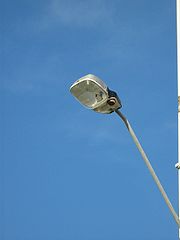 the town at dusk, lighting each of the lamps, but later designs employed ignition devices that would automatically strike the flame when the gas supply was activated. The earliest of such street lamps were built in the Arab Empire, especially in Córdoba, Spain.
the town at dusk, lighting each of the lamps, but later designs employed ignition devices that would automatically strike the flame when the gas supply was activated. The earliest of such street lamps were built in the Arab Empire, especially in Córdoba, Spain.
The first electric street lighting employed arc lamps, initially the ‘Electric candle’, ‘Jablotchkoff candle’ or ‘Yablochkov candle‘ developed by the Russian Pavel Yablochkov in 1875. This was a carbon arc lamp employing alternating current, which ensured that both electrodes were consumed at equal rates. Yablochkov candles were first used to light the Grands Magasins du Louvre, Paris where 80 were deployed. Soon after, experimental arrays of arc lamps were used to light Holborn Viaduct and the Thames Embankment in London – the first electric street lighting in Britain. More than 4,000 were in use by 1881, though by then an improved differential arc lamp had been developed by Friederich von Hefner‑Alteneck of Siemens & Halske. The United States was swift in adopting arc lighting, and by 1890 over 130,000 were in operation in the US, commonly installed in exceptionally tall moonlight towers.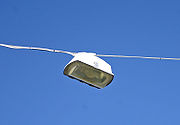
The first street in the UK to be lit by electric light was Mosley Street, in Newcastle-upon-Tyne. The street was lit by Joseph Swan’s incandescent lamp in February, 1879. The first in the United States, and second overall, was the Public Square road system in Cleveland, Ohio, on April 29, 1879. Wabash, Indiana holds the title of being the third electrically-lit city in the world, which took place on February 2, 1880. Four 3,000 candlepower Brush arc lamps suspended over the courthouse rendered the town square “as light as midday.” Kimberley, South Africa, was the first city in Africa to have electric street lights – first lit on 1 September 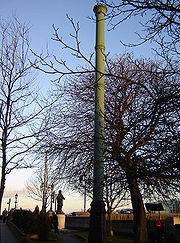 1882. In Latin America, San Jose, Costa Rica was the first city, the system was launched on August 9, 1884, with 25 lamps powered by an hydroelectric plant. Timişoara, in present-day Romania, was the first city in mainland Europe to have electric public lighting on the 12 of November 1884. 731 lamps were used. In 1888 Tamworth, New South Wales, Australiabecame the first location in the Southern Hemisphere to have electric street lighting, giving the city the title of “First City of Light”.
1882. In Latin America, San Jose, Costa Rica was the first city, the system was launched on August 9, 1884, with 25 lamps powered by an hydroelectric plant. Timişoara, in present-day Romania, was the first city in mainland Europe to have electric public lighting on the 12 of November 1884. 731 lamps were used. In 1888 Tamworth, New South Wales, Australiabecame the first location in the Southern Hemisphere to have electric street lighting, giving the city the title of “First City of Light”.
Arc lights had two major disadvantages. First, they emit an intense and harsh light which, although useful at industrial sites like dockyards, was discomforting in ordinary city streets. Second, they are maintenance-intensive, as carbon electrodes burn away swiftly. With the development of cheap, reliable and bright incandescent light bulbs at the end of the 19th century, they passed out of use for street lighting, but remained in industrial use longer.
Incandescent lamps were primarily used for street lighting until the advent of high-intensity discharge lamps. They were often operated in high-voltageseries circuits. Series circuits were popular since the higher voltage in these circuits produced more light per watt consumed. Furthermore, before the invention of photoelectric controls, a single switch or clock could control all the lights in an entire district.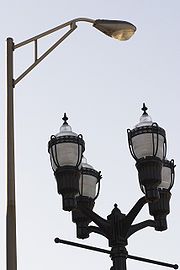
To avoid having the entire system go dark if a single lamp burned out, each street lamp was equipped with a device that ensured that the circuit would remain intact. Early series street lights were equipped with isolation transformers that would allow current to pass across the transformer whether the bulb worked or not. Later the film cutout was invented. The film cutout was a small disk of insulating film that separated two contacts connected to the two wires leading to the lamp. If the lamp failed (an open circuit), the current through the string became zero, causing the voltage of the circuit (thousands of volts) to be imposed across the insulating film, penetrating it (see Ohm’s law). In this way, the failed lamp was bypassed and power restored to the rest of the district. The street light circuit contained an automatic voltage regulator, preventing the current from increasing as lamps burned out, preserving the life of the remaining lamps. When the failed lamp was replaced, a new piece of film was installed, once again separating the contacts in the cutout. This system was recognizable by the large porcelain insulator separating the lamp and reflector from the mounting arm. This was necessary because the two contacts in the lamp’s base may have operated at several thousand volts above ground/earth.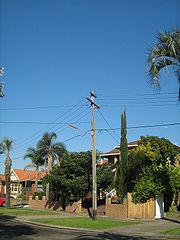
Today, street lighting commonly uses high-intensity discharge lamps, often HPS high pressure sodium lamps. Such lamps provide the greatest amount of photopic illumination for the least consumption of electricity. However when scotopic/photopic light calculations are used, it can been seen how inappropriate HPS lamps are for night lighting. White light sources have been shown to double driver peripheral vision and increase driver brake reaction time at least 25%. When S/P light calculations are used, HPS lamp performance needs to be reduced by a minimum value of 75%. This is now a standard design criteria for Australian roads.
New street lighting technologies, such as Light Emitting Diode (LED) and Induction emit a white light that provides high levels of scotopic lumens allowing street lights with lower wattages and lower photopic lumens to replace existing street lights. However, there have been no formal specifications written around Photopic/Scotopic adjustments for different types of light sources, causing many municipalities and street departments to hold back on implementation of these new technologies until the standards are updated.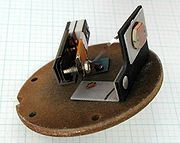
Disadvantages
The major criticisms of street lighting are that it can actually cause accidents if misused, and cause light pollution.
Dangers of street lights
There are two optical phenomena that need to be recognized in street light installations.
- The loss of night vision because of the accommodation reflex of drivers’ eyes is the greatest danger. As drivers emerge from an unlighted area into a pool of light from a street light their pupils quickly constrict to adjust to the brighter light, but as they leave the pool of light the dilation of their pupils to adjust to the dimmer light is much slower, so they are driving with impaired vision. As a person gets older the eye’s recovery speed gets slower, so driving time and distance under impaired vision increases.
- Oncoming headlights are more visible against a black background than a grey one. The contrast creates greater awareness of the oncoming vehicle.
- Stray voltage is also a concern in many cities. Stray voltage can accidentally electrify light poles and has the potential to injure or kill anyone who comes into contact with the pole.[9] Some cities have employed the Electrified Cover Safeguard technology which sounds an alarm and flashes a light, to warn the public, when a pole becomes dangerously electrified.
There are also physical dangers. Street light stanchions (poles) pose a collision risk to motorists. This can be reduced by designing them to break away when hit (frangible or collapsible supports), protecting them by guardrails, or marking the lower portions to increase their visibility. High winds or accumulated metal fatigue also occasionally topple street lights.
Light pollution
In urban areas light pollution can hide the stars and interfere with astronomy. In settings near astronomical telescopes and observatories, low pressure sodium lamps may be used. These lamps are advantageous over other lamps such as mercury and metal halide lamps because low pressure sodium lamps emit lower intensity, monochromatic light. Observatories can filter the sodium wavelength out of their observations and virtually eliminate the interference from nearby urban lighting.
The light pollution also disrupts the natural growing cycle of plants.[citation needed]
Purposes of street lights
There are three distinct main uses of street lights, each requiring different types of lights and placement. Misuse of the different types of lights can make the situation worse by compromising visibility or safety.
Beacon lights
A modest steady light at the intersection of two roads is an aid to navigation because it helps a driver see the location of a side road as he comes closer to it and he can adjust his braking and know exactly where to turn if he intends to leave the main road or see vehicles or pedestrians. A beacon light’s function is to say “here I am” and even a dim light provides enough contrast against the dark night to serve the purpose. To prevent the dangers caused by a car driving through a pool of light, a beacon light must never shine onto the main road, and not brightly onto the side road. In residential areas, this is usually the only appropriate lighting, and it has the bonus side effect of providing spill lighting onto any sidewalk there for the benefit of pedestrians. On Interstate highways this purpose is commonly served by placing reflectors at the sides of the road.
Roadway lights
Street lights are not normally intended to illuminate the driving route (headlights are preferred), but to reveal signs and hazards outside of the headlights’ beam[citation needed]. Because of the dangers discussed above, roadway lights are properly used sparingly and only when a particular situation justifies increasing the risk. This usually involves an intersection with several turning movements and much signage, situations where drivers must take in much information quickly that is not in the headlights’ beam. In these situations (A freeway junction or exit ramp) the intersection may be lit so that drivers can quickly see all hazards, and a well designed plan will have gradually increasing lighting for approximately a quarter of a minute before the intersection and gradually decreasing lighting after it. The main stretches of highways remain unlighted to preserve the driver’s night vision and increase the visibility of oncoming headlights. If there is a sharp curve where headlights will not illuminate the road, a light on the outside of the curve is often justified.
If it is desired to light a roadway (perhaps due to heavy and fast multilane traffic), to avoid the dangers of casual placement of street lights it should not be lit intermittently, as this requires repeated eye reajustment which implies eyestrain and temporary blindness when entering and leaving light pools. In this case the system is designed to eliminate the need for headlights. This is usually achieved with bright lights placed on high poles at close regular intervals so that there is consistent light along the route. The lighting goes from curb to curb.
Research a few years ago suggested that by comparison to other countries, more pedestrians are hit by motor vehicles at night in Britain.[citation needed] The theory behind this was that Britain almost exclusively, used low pressure sodium street lighting, (LPS); unlike the rest of the world that use mercury vapour gas discharge lighting[citation needed]. This was most noticeable when flying in from Europe at night and seeing a warm orange glow when approaching Britain. LPS lighting, being monochromatic, shows pedestrians as shadowy forms, unlike other forms of street lighting. In recognition of this, pedestrian crossings are now lit by additional “white” lighting,[citation needed] and sodium lighting is being replaced by modern types.[citation needed]
Security lighting
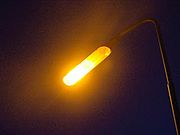 Security lighting is similar to high-intensity lighting on a busy major street, with no pools of light and dark, but with the lighted area extending onto people’s property, at least to their front door. This requires a different type of fixture and lens. The increased glare experienced by drivers going through the area might be considered a trade-off for increased security. This is what would normally be used along sidewalks in dense areas of cities. Often unappreciated is that the light from a full moon is brighter than most security lighting.
Security lighting is similar to high-intensity lighting on a busy major street, with no pools of light and dark, but with the lighted area extending onto people’s property, at least to their front door. This requires a different type of fixture and lens. The increased glare experienced by drivers going through the area might be considered a trade-off for increased security. This is what would normally be used along sidewalks in dense areas of cities. Often unappreciated is that the light from a full moon is brighter than most security lighting.
Main manufacturers of street lanterns and/or bulbs
Australia
America
- Cooper Lighting division of Cooper Industries
- General Electric, USA.
- Osram Sylvania
- Westinghouse Lighting Corporation (formerly Angelo Brothers) division of the new Westinghouse Electric
- American Electric Lighting Corporation
- American Green Lights, San Diego, CA
Europe
- Osram, Germany.
- Philips, the Netherlands.
- Industria, the Netherlands.
- Schreder, Belgium.
- Siemens, Germany.
- Svetlina AD, Bulgaria.
- Aura Light, Sweden.
- AEC Illuminazione, Italy.
- Tungsram, Hungary
- Art Metal, Poland.
- Innolumis, Netherlands.
EGL Energy Europe, Poland
United Kingdom
Asia
- Matsushita Electric Industrial Co., Japan
- Sanyo, Japan
- NeoPac, Taiwan
Street light interference
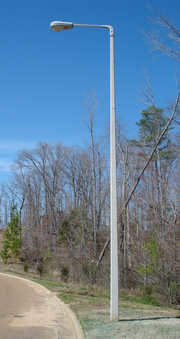 Street light interference, or SLI, is an alleged anomalous phenomenon where
Street light interference, or SLI, is an alleged anomalous phenomenon where 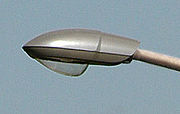 a person seems to turn off (or sometimes on) street lights, or outside building security lights, when passing near them.
a person seems to turn off (or sometimes on) street lights, or outside building security lights, when passing near them.
Although street lights sometimes turn on and off by chance (especially at the end of their life cycle), believers in street light interference tend to claim that it happens to them personally on a regular basis, more frequently than chance would explain. Some propose paranormal explanations for SLI, sometimes based on scientific terminology, such as the explanation that electrical impulses in their brain interfere with the workings of electric lights. Anecdotes about people’s experiences of SLI have been reported by news sources.
SLI has never been demonstrated to occur in a scientific experiment, and those who claim to cause it have been found to be unable to reproduce the effect on demand; they give the explanation that the effect is not within their mental and physical control. Many times they do report, however, that it occurs with specific lamps and not just randomly shutting off street lights or electrical lamps in general.
Hilary Evans and The SLI Effect
Hilary Evans, an English author who writes about paranormal subjects, coined the word “SLIder” to refer to someone who causes this effect, in his bookThe SLI Effect. In this book on page 15 he explains that a wide variety of street lamp types show the effect,
| “ | the effect is spontaneous and is apparently meaningless; it serves no practical purpose, nor does it seem
to provide satisfaction for the individual or in any other way serve some kind of psychological purpose. |
” |
In the preface of the book Evans says,
| “ | SLI is an apparent phenomenon, based on claims by many people that they involuntarily, and usually spontaneously, cause street lamps to go out. Generally the effect is intermittent, infrequent and without an immediately discernible sequence of cause and effect. SLI deserves study because it gives the appearance of being an anomalous phenomenon in its own right. That is to say, it appears to be an effect which is not consistent with our current knowledge of how people interact with the physical world, and which occurs in specific circumstances. | ” |
On page 16 he explains what seems most likely to be happening,
| “ | Most commentators, confronted with the Street Light Interference phenomenon, look – and rightly – for a straightforward physical explanation. For example, when Robert McMorris of the Omaha World-Herald devoted two or three issues of his regular column to SLI reports in January 1990, he quoted Allen Klostermeyer, manufacturer’s representative for Lighting Specialists Inc., who pointed out that when a sodium (amber) bulb nears the end of its useful life, it may go into an off-and-on sequence:
|
” |
| “ | This, it was suggested, is sufficient to explain the SLI effect; what happens is that the witness just happens to be passing such a lamp during its death-throes, and is led by the synchronicity to imagine that he is somehow responsible. But as the testimony shows, even if we allow the coincidence in place and time, this effect could account for only a small fraction of the reported cases. For one thing, other types of lamp are involved besides sodium lamps. Then again, only a small number of reports describe anything like an SL going off, then on, then off again. And what about when a witness extinguishes a whole batch of SLs: are we to conclude that the whole batch was purchased together, and so shared the same life-span, and such was the perfection of their manufacture, that they all reached their death-point simultaneously? Yet even if we allow that, there is still the fact that some SLIders extinguish a row of SLs in sequence, each one going out as the witnesses nears it: it is asking too much to suppose that a series of lamps would have been arranged in order of their life-span. |
Skepticism of SLI
The skeptical explanation to claims of SLI is to consider it an example of confirmation bias: people are much more likely to notice when a street light near them turns on or off than they are to notice a street light in a steady state. This is compounded by a failure mode of street lights, known as “cycling”, in which street lights turn off and on more frequently at the end of their life cycle. Also, a bizarre personal causal inference, especially in the case of inferring a relationship from one or few instances, is known as magical thinking. A top high pressure sodium engineer at General Electric, quoted by Cecil Adams, summarizes that SLI is “a combination of coincidence and wishful thinking”. Massimo Polidoro notes in Skeptical Inquirer that “Paranormal phenomenon is the least likely possibility.”
Strobe light
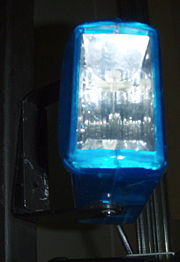 Strobe light or stroboscopic lamp, commonly called a strobe, is a device used to produce regular flashes of light. It is one of a number of devices that can be used as a stroboscope. The word originated from the Greek strobos, meaning “act of whirling.”
Strobe light or stroboscopic lamp, commonly called a strobe, is a device used to produce regular flashes of light. It is one of a number of devices that can be used as a stroboscope. The word originated from the Greek strobos, meaning “act of whirling.”
Strobe lights are used in scientific and industrial applications, in clubs where they are used to give an illusion of slow motion (cf. stroboscopic effect) and for aircraft anti-collision lighting. Other applications are in alarm systems, theatrical lighting (most notably to simulate lightning), and as high-visibility running lights. They are still widely used in law enforcement and other emergency vehicles, though they are slowly being replaced by LEDtechnology in this application, as they themselves largely replaced halogen lighting. Strobes are used by scuba divers as an emergency signaling device.[1] Strobe lighting has also been used to see the movements of the vocal cords in slow motion during speech, a procedure known as video-stroboscopy. Special calibrated strobe lights, capable of flashing up to hundreds of times per second, are used in industry to stop the motion of rotating and other repetitively-operating machinery and to measure the rotation speeds or cycle times. Strobelights are often used in nightclubs and raves, and are available for home use for special effects or entertainment.
A typical commercial strobe light has a flash energy in the region of 10 to 150 joules, and discharge times as short as a few milliseconds, often resulting in a flash power of several kilowatts. Larger strobe lights can be used in “continuous” mode, producing extremely intense illumination.
The light source is commonly a xenon flash lamp, which has a complex spectrum and a color temperature of approximately 5,600 kelvins. To obtain colored light, colored gels must be used.
History
The origin of strobe lighting dates to 1931, when Harold Eugene “Doc” Edgerton employed a flashing lamp to make an improved stroboscope for the study of moving objects, eventually resulting in dramatic photographs of objects such as bullets in flight.
EG&G [now a division of URS] was founded by Harold E. Edgerton, Kenneth J. Germeshausen and Herbert E. Grier in 1947 as Edgerton, Germeshausen and Grier, Inc. and today bears their initials. In 1931, Edgerton and Germeshausen had formed a partnership to study high-speed photographic and stroboscopic techniques and their applications. Grier joined them in 1934, and in 1947, EG&G was incorporated. During World War II, the government’s Manhattan Project made use of Edgerton’s discoveries to photograph atomic explosions; it was a natural evolution that the company would support the Atomic Energy Commission in its weapons research and development after the war. This work for the Commission provided the historic foundation to the Company’s present-day technology base.
The strobe light was popularized on the club scene during the 1960s when it was used to reproduce and enhance the effects of LSD trips. Ken Kesey used strobe lighting in coordination with the music of the Grateful Dead during his legendary Acid Tests.
Strobe lights and epilepsy
Strobe lighting can trigger seizures in photosensitive epilepsy. Thus, most strobe lights on sale to the public are factory-limited to about 10-12 flashes per second in their internaloscillators, although externally triggered strobe lights will often flash as frequently as possible. At a frequency of 10 Hz, 65% of affected people are still at risk. The British Health and Safety Executive recommend that a net flash rate for a bank of strobe lights does not exceed 5 flashes per second, at which only 5% of photosensitive epileptics are at risk. It also recommends that no strobing effect continue for more than 30 seconds due to the potential for discomfort and disorientation.
Solar lamp
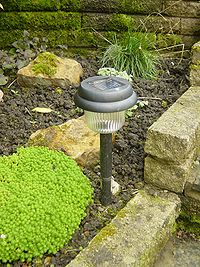 A solar lamp is a portable light fixture composed of an incandescent lamp or LED, a solar panel and a small rechargeable battery.
A solar lamp is a portable light fixture composed of an incandescent lamp or LED, a solar panel and a small rechargeable battery.
It generally includes Ni-MH or Ni-Cd AA batteries, 2V/40mA solar panel and 12000mcd-15000mcd LED.
It can be used as outdoor (lawn and garden), indoor (i.e. a desk lamp used to read or study, with a brightness equivalent to 40 watts ) or as both type of lamps.
Discharging time is generally 8 to 10 hours.
Solar Lights
Solar Lights better known as landscaping lights are lights that are charged up during the day from the sun’s light. At dusk, they turn on automatically, and remain illuminated overnight, depending on how much sunlight they receive during the day. They must be placed in a position where they receive as much direct sunlight as possible during the day, as solar lights can fail to illuminate at night if placed in shady positions. 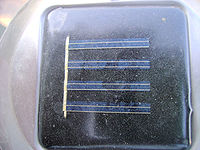 Depending on the brand, some solar lights will not illuminate on rainy or cloudy days because they have not been able to recharge without sunlight. Solar lights are generally waterproof if sealed correctly. Most brands require rechargeable batteries, which are charged by solar power during the day, and can last up to 12 months. Solar lights do not provide as much light as a standard electrical lighting system, but they are easily installed and maintained, and provide a much cheaper alternative to electrical based products.
Depending on the brand, some solar lights will not illuminate on rainy or cloudy days because they have not been able to recharge without sunlight. Solar lights are generally waterproof if sealed correctly. Most brands require rechargeable batteries, which are charged by solar power during the day, and can last up to 12 months. Solar lights do not provide as much light as a standard electrical lighting system, but they are easily installed and maintained, and provide a much cheaper alternative to electrical based products.
You can buy solar lights at:
United States
Australia
- –Bunnings Warehouse
- –K-Mart– Available at stores with a gardening section.
- –Big W – Gardening section
- –Target – Available at stores with a gardening section.
Purpose
Solar lights keep areas around your home safe at night, especially around footpaths. They can be placed in any part of the garden for an attractive visual display at night, especially in flower beds and rockeries. They can also be used around swimming pools.
Security lighting
In the field of physical security, security lighting is often used as a preventative and corrective measure against intrusions or other criminal activity on a physical piece of property. Security lighting may be provided to aid in the detection of intruders, to deter intruders, or in some cases simply to increase the feeling of safety. Lighting is integral to Crime prevention through environmental design.
Planning considerations
Some people are surprised to learn that security lighting can be counter-productive. Turning off lights halved the number of thefts and burglary in Övertorneå Sweden. A test in West Sussex UK showed that adding all-night lighting in some areas made people there feel safer, although crime rates increased 55% in those areas compared to control areas and to the county as a whole.
| “ | In the early seventies, the public-school system in San Antonio, Texas, began leaving many of its school buildings, parking lots, and other property dark at night and found that the no-lights policy not only reduced energy costs but also dramatically cut vandalism. | ” |
Bright, unshielded floodlights often prevent people from noticing criminal activity, and help criminals see what they are doing.
While adequate lighting around a physical structure is deployed to reduce the risk of an intrusion, it is critical that the lighting be designed carefully as poorly arranged lighting can createglare which actually obstructs vision. Studies[citation needed] have shown that many criminals are aware of this effect and actively exploit it. The optimal design will also depend on whether the area will be watched directly by humans or by closed-circuit television, and on the location of the observers or cameras.
Security lighting may be subject to vandalism, possibly to reduce its effectiveness for a subsequent intrusion attempt. Thus security lights should either be mounted very high, or else protected by wire mesh or tough polycarbonate shields. Other lamps may be completely recessed from view and access, with the light directed out through a light pipe or reflected from a polished aluminium or stainless steel mirror. For similar reasons high security installations may provide a stand-by power supply for their security lighting.
Some typical considerations include:
- Reduce and prevent glare and situations mentioned above
- Shielded or full cut-off (FCO) lamp housings which conceal the bulb could be used, which should direct light onto the ground or target and away from observers. These lights should send no light above 80 degrees from the nadir. Lighting should be bright enough, and not “as bright as possible”. In many cases a good rule of thumb is 0.5 watts per square metre(0.05 watts per square foot). This might need to be increased in very confused environments, but conversely can be reduced in very open environments. Multiple lamps of moderate power instead of a few powerful lamps will reduce glare, provide more even illumination with reduced pools of shadow, and provide some redundancy if one lamp’s bulb blows out or develops a bad ballast.
- Prevent malicious tampering or interference. This means that besides the lamp itself, the entire circuit from the source (Electric company or generator), through the wires, to the lamp and back should be protected.
- Luminaires should be accessible so that the maintainer can replace blown bulbs as quickly as possible and clean the luminaires periodically. However they should be protected or somehow made inaccessible to tampering.
- Ensure the electric meter box is locked or inaccessible, or else power the lights from a different line.
- Control and power lines, where outside or vulnerable, should be either buried well underground (in conduits preferably) or at a height of at least 8 metres (about 24 feet).
- Ideally multiple circuits should be used to prevent an accidental or malicious short or cut causing all illumination to fail.
Use
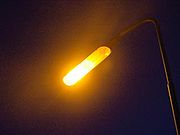 Security lighting can be used in residential, commercial, industrial, institutional, and military settings. Some examples of security lighting includefloodlights and low pressure sodium vapour lights. Most lights intended to be left on all night are high-intensity discharge lamps as these have good energy efficiency, thus reducing the cost of running a lamp for such long periods.
Security lighting can be used in residential, commercial, industrial, institutional, and military settings. Some examples of security lighting includefloodlights and low pressure sodium vapour lights. Most lights intended to be left on all night are high-intensity discharge lamps as these have good energy efficiency, thus reducing the cost of running a lamp for such long periods.
A disadvantage of low pressure sodium lamps is that the colour is pure yellow, so the illuminated scene is seen without any colour differentiation. Consequently high pressure sodium vapour lamps (which are still yellowish, but closer to golden white) are also used, at the cost of greater running expenses and increased light pollution. High pressure sodium lamps also take slightly longer to restrike after a power interruption.
Other lights may be activated by sensors such as passive infrared sensors (PIRs), turning on only when a person (or other mammal) approaches. PIR activated lamps will usually be incandescent bulbs so that they can activate instantly; energy saving is less important since they will not be on all the time. PIR sensor activation can increase both the deterrent effect (since the intruder knows that he has been detected) and the detection effect (since a person will be attracted to the sudden increase in light). Some PIR units can be set up to sound a chime as well as turn on the light. Most modern units have a photocell so that they only turn on when it is dark.
Recent developments
A recent addition to the field of security lighting is the blue outdoor lamp (similar to mercury-vapor lamps), used to illuminate areas which have been used by drug addicts to inject drugs. The idea is that the blue lighting makes it impossible to identify veins, thus discouraging the addicts from using that location to “shoot up” and then discard needles.
Limitations
An important limitation to the usefulness of security lighting is the simple fact that it is only useful at night. This is particularly significant for home owners because, contrary to a widespread myth, most household burglaries occur during the day, when the occupants are away at work or shopping.
As with any lighting, security lighting can reduce night vision, making it harder to see into areas that are unlit or are in shadow.
